| Ken Sakamura |
 |
|
 |
 |
 |
|
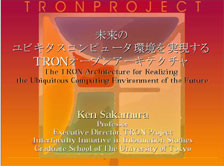
Slide 01
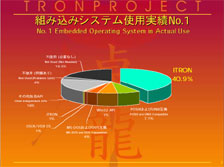
Slide 02
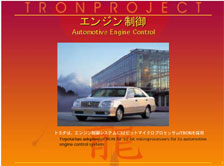
Slide 03
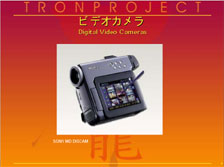
Slide 04
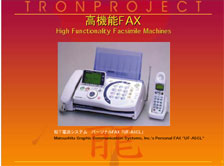
Slide 05
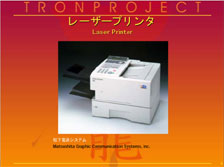
Slide 06
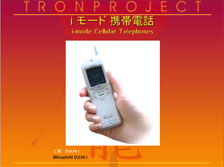
Slide 07
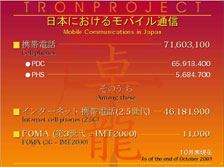
Slide 08
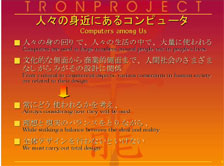
Slide 09
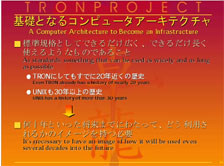
Slide 10
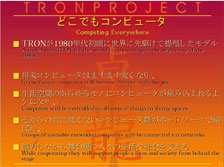
Slide 11 |
Slide
01, Front Cover
Thank you for that kind introduction. Hello, my name is Ken Sakamura, and I am from the University of Tokyo.
I am very honored to be able to stand before you, chairman Takeda, the directors of the Takeda Foundation, and the honored guests from around the world, to accept the Takeda Award 2001. Strictly speaking, the actual award will be presented tomorrow, but I would like to again express my most sincere thanks for such a great honor.
The prospectus for the Takeda award states that it is given to those who have made people's lives richer and happier through the creation and utilization of Engineering Intellect and Knowledge. I am very proud and happy to be able to receive such an award. You see, I love computers, and I have always hoped that these computers I love could make people's lives richer and happier. And in my work, I have always believed that they could.
Slide 02 - Pie Graph/03 - Automobile/04 - Camera/05 - Fax/06 - Laser Printer/07 - Cell Phone/08 - Statistics
I started the TRON project, a cooperative effort between industry and academia, in 1984. And I am pleased to report to you that, as we enter the 21st century, the embedded real-time operating system created by the TRON project has become the most-used worldwide. TRON is probably the computer system you all have the most contact with. An operating system is the core piece of software in a computer system. When it comes to PCs, on the global scale US-made operating systems have conquered the industry, but the products of my TRON project are used in the devices all around you. They are being used as embedded systems for automotive engine control, and to control such devices as car navigation systems, video cameras, digital cameras, faxes, laser printers, copiers, cell phones, and more.
The spread of the PC tends to make us overlook this fact, but in reality this type of embedded system is the most common type of computer in use today. And TRON is the most-used system in this field. For example, I imagine that most of you here today have cell phones. If that cell phone is Internet capable, I can guarantee that it has a TRON system in it. I think that this has shown you what I mean when I say that TRON is the computer system you all have the most contact with.
Slide 09 - Computers among Us
Research on computers focuses on things like how to carry out huge computations incredibly quickly -- in the automotive world, this would be like working on how to build race cars. Continuing with the automotive analogy, my work on computers has focused on making compact cars. Making a "compact car" computer isn't as simple as just making it small.
When you're aiming to make the fastest computer you can make, there will be all sorts of demand for your product. But when you're making the smallest computer you can make, you don't always end up with something useful. For instance, reducing the size might slow down response times to an unacceptable level. You've always got to be thinking about what this can be used for.
Huge numbers of computers - smaller computers in particular - are used around us; they are part of our lives. That is why designing small computers doesn't just involve technical issues. All the barriers and limitations of human society, including cultural and industrial ones, come into play as well.
The most similar situation in engineering is probably architecture. I call my field of specialization computer architecture; I think that the need to decide on an overall design that balances ideal with reality, always taking into consideration how the end product will be used, is what building architecture and computer architecture have in common. Some other similarities are how what you create only has meaning when it is finished and functioning, and how the cooperation of a large number of people are required to complete it.
Slide 10 - A Computer Architecture to Become an Infrastructure
But on the other hand, there are differences between building architecture and computer architecture as well. With building architecture, you create each project independently of the others. In contrast, today's computer architectures are not built independently. There is a demand for that architecture to become a standard, to allow it to be used as widely and for as long as possible. As a computer architecture comes to be used longer and more widely, more peripheral devices become available, the development environment improves, easier-to-use software libraries are developed, and easier-to-understand learning materials become available. And these peripheral improvements then give rise to a kind of virtuous circle, where it becomes easier to build a system on top of this infrastructure.
In the same way that a dog ages seven years for each year that a person ages, they say that progress in the computer world is measured in dog years. That is how fast the computer field is moving. But computer infrastructure is different. My TRON project has been around for nearly 20 years, and UNIX, with which the two gentlemen accepting the award with me this year are involved, has a more than 30-year history. This is probably a sign of how special this computer field is.
It is vital to keep computer infrastructure in use for as long as possible, so that the efforts of the many who have built on top of that infrastructure are not wasted. This is all the more reason why the infrastructure must be designed with an image of how it will be used even several decades into the future.
To be sure, the computer architecture field is strewn with hurdles. It's never an open-and-shut case of "all I have to do is build some fast switching devices." But for me, it's fun to think about how computers will be used in the society of the future. I am totally convinced that this is the field for me.
Slide 11 - Computing Everywhere
Now, I would like to talk about how the TRON project envisioned future computer use when it was founded.
The 1970s saw the emergence of the microcomputer. I felt these microcomputers had great possibilities. I believed that in the future, computers would become cheaper and cheaper, and would come to be embedded in all sorts of the devices we see and use every day. Eventually, computers would be embedded in every part of our living environments: in the ceilings, in the walls, in the floors - and in every piece of furniture and device in between. These invisible computers would be linked by networks, working together behind the scenes like little unseen helpers to make our lives easier and help society. This "Computing Everywhere" environment is the future I envisioned for the computer. In the early 1980s, the TRON project led the world in proclaiming this vision of the ubiquitous computer of the future. At the time, large-scale artificial intelligence research was a hot topic in Japan, and there weren't many people who agreed with my vision. It wasn't until the 1990s, when in the United States MIT and Xerox Palo Alto Research Center came up with concepts like "ubiquitous computing" and "pervasive computing" that related fields began to take off.
|
|
|